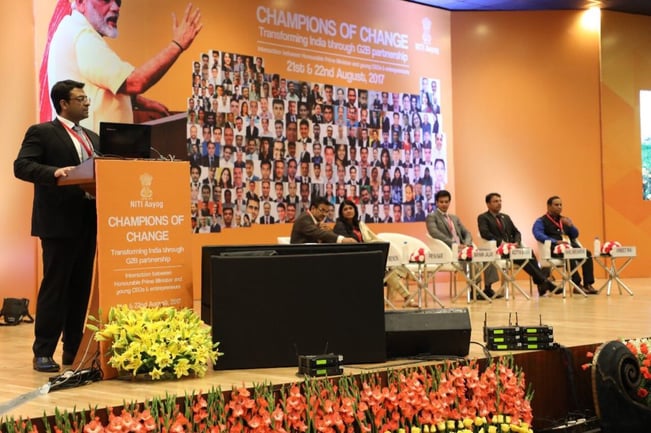Indian government breaks new ground in group brainstorming

2022 marks 75 years since the Quit India movement was launched by Mahatma Gandhi.
It’s the movement that led to India’s independence from Britain, a momentous milestone for the people of India, and one that the Indian government wants to commemorate in memorable fashion.
It’s also the inspiration behind a massive new initiative: A New India by 2022.
The brainchild of Prime Minister Narendra Modi, the program focuses almost exclusively on finding new ways to innovate within six areas crucial to the Indian economy. The goal, according to PM Modi, is to “create the India that our freedom fighters would be proud of.”
Let us work shoulder to shoulder to create the India that our freedom fighters would be proud of. #SankalpSeSiddhi https://t.co/TYuxNNJfIf
— Narendra Modi (@narendramodi) August 9, 2017
Collecting ideas from hundreds of attendees
With the goal of accelerating innovation firmly established, NITI Aayog, the National Institution for Transforming India, hosted a conclave dubbed Champions of Change. At this momentous event, more than 200 titans of industry met with representatives of the Indian government. First on the agenda: creating a dialogue between the private and public sectors.
“Diverting from the boring format of one-way discussions and speeches from the government, the event was modelled on a corporate event. Where groups of 35 people brainstormed on the six chosen themes – New India, Make In India, Cities Of Tomorrow, World Class Infrastructure, Doubling Farmers Income and Fixing Finance.” — Shweta Modgil, writing for Inc42
The rationale was simple. Private enterprise generally outpaces government in the field of innovation. If innovation is the name of the game, then why not tap into India’s greatest source of innovation: the private sector?
What was needed, then, was a brainstorming session of epic scale. Event organizers would facilitate this brainstorming session, using Poll Everywhere to collect the thoughts, ideas, and concerns of all 200 entrepreneurs in attendance.
Later, the ideas that would emerge from this brainstorming session would be presented to the Prime Minister himself. And the government would work to incorporate the new ideas in the coming years.
Presenting to the PM! Super proud to share my work on “Make in India” #championsofchange #nitiaayog pic.twitter.com/9gbRq9tvdH
— Devita Saraf (@DevitaSaraf) August 23, 2017
Following this format, organizers believed, the world’s most populous nation could usher in “A New India by 2022.”
Channeling the ideas of 200+ people into actionable steps

Collecting feedback from more than 200 people is a tall order. Sifting through that feedback, too, is challenging. Using that prioritized feedback to spur discussion and productive debate amongst a huge group of people — each of whom are likely used to being the dominant voice at the table — is the difference between chaos and progress.
Sifting through the responses collected through a Poll Everywhere Q&A, attendees addressed tough topics and cleared their collective doubts on policy issues. They upvoted responses so that they could be addressed by government secretaries in attendance, such as the Indian Finance Minister.
After submitting feedback and upvoting the most compelling issues, attendees broke into six groups: one for each of the six themes identified by the Indian government as ripe for innovation.
A NITI Aayog facilitator was assigned to each group, and the resulting breakaway sessions dove deeper into the topics each group was responsible for. The groups worked together to synthesize their approach, and prepared it for presentation to Prime Minister Modi.
“What started… as a flurry of emails, calls, and Whatsapp groups cemented into constructive group meetings focused on the theme at hand: groups with domain knowledge collaborated and provided inputs with targeted action points to bring about change.” — NITI Aayog
One of the 200 CEOs to attend the event, Eko India Financial Services CEO Abhishek Sinha, described the excitement that permeated the room. “The PM indicated that he may institutionalise this sort of a dialogue with entrepreneurs and have it every six months or once a year,” Sinha said. “That could be a great thing.”